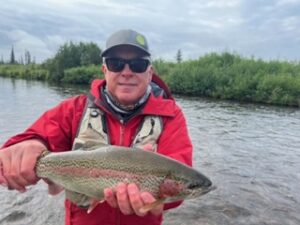0 Comments
Mark Miller
Myth number one is “that Alaskan rainbow trout are larger than their cousins in the lower 48”. Truth is they are not. What natural or human induced factors decide how large a rainbow trout is?… lots of food and warm waters…usually deeper lake systems.
In Alaska we have three different “same species” of rainbows. Small landlock lakes or smaller rivers with limited food sources have smaller fish…maybe average large fish is about 14 inches. Rivers with lots of feed have lots of larger rainbows maybe averaging 18 inches on up. Southwest Alaska has large deep lake systems with large river systems draining into Bristol Bay.
The fish may winter in the deep lakes with lots of food such as – salmon fry and freshwater shrimp, then these trout travel into the rivers during Alaskan’s warmer months. Rainbows that home in larger lakes are typically larger, some call them lake fish or “chromers” which often reach lengths of 30 inches plus. These large rainbows often take on the looks of steelheads which I believe they are.

I’ve often got into disagreements that steelheads are catadromous (travel between salt and fresh waters). At that time, I ask these deniers “what about the Great Lakes steelhead”?
Alaskan fishing guides have come up with a term for native river rainbow and called them leopard trout as many of these fish have spots over their entire body included their eyes. These rainbows typically have the large red stripe down their sides and are much more colorful.
I live most of the year on the banks of the Talachulitna River which is located about 70 air miles west of Anchorage along the eastern slopes of the Alaskan Range. The Talachulitna River was the first in the state designated a rainbow hook and release river. After forty years plus guiding anglers on this river and nearby tributaries, I’ve noticed that our trout have gotten exceedingly larger the last five or six years. We’ve taken beautiful colored rainbows up to 26 inches in length and many over 20 inches. My conclusion is “lots of feed”.
In the northern Cook Inlet drainage, typically pink salmon arrive in the rivers to spawn in HUGE numbers every even year. These salmon arrive in such large numbers that their spawning actions muddy the rivers and flood them with salmon eggs. I can only imagine the numbers of pink salmon fry leaving our rivers and offering our trout a second course meal. About eight years ago, pink salmon got confused and arrive every year in large numbers. Our rainbow trout have gone from an average of 16 inches to about 18-20. Lots of feed means our trout can live longer and grow larger.
Yes, the availability of lots of food is important to the growth of any fish and surely our local trout have seen the food’s benefit both in size and health.
Good fishing to you all.

Leave a Reply